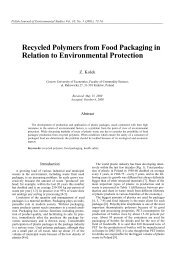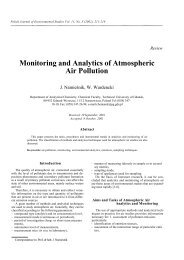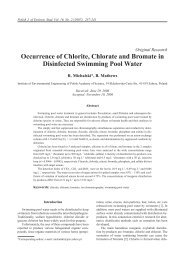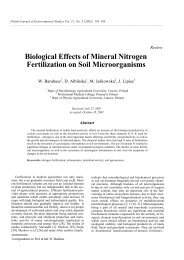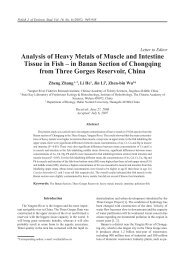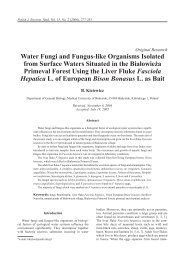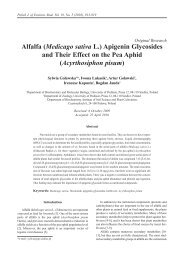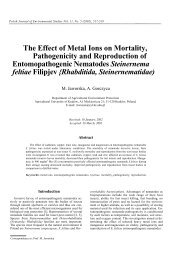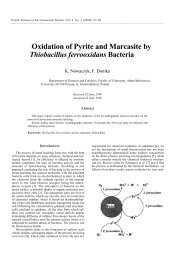Ecological Replacements of Ozone-Depleting Substances
Ecological Replacements of Ozone-Depleting Substances
Ecological Replacements of Ozone-Depleting Substances
You also want an ePaper? Increase the reach of your titles
YUMPU automatically turns print PDFs into web optimized ePapers that Google loves.
418<br />
Wachowski L. et al.<br />
by S. Chapman [8, 81]. According to this concept, the<br />
ozone is formed in the upper atmosphere above 30 km in<br />
altitude when solar ultraviolet radiation is adsorbed by<br />
molecular oxygen, breaking the molecular bond and<br />
yielding two free atoms:<br />
0 2 + hν -> O + O (1)<br />
A free oxygen atom can then combine with an oxygen<br />
molecule to form ozone. This photodissociation is followed<br />
by a secondary thermal reaction (2) leading to O 3<br />
formation:<br />
O 2 + O + M -> O 3 + M (2)<br />
where M is a third neutral body such as an oxygen or<br />
nitrogen molecule. The formation <strong>of</strong> atomic oxygen in<br />
the primary reaction (1) is brought about by ultraviolet<br />
radiation (UV-C) with wavelengths λ < 242 nm in the<br />
upper atmosphere. <strong>Ozone</strong> itself undergoes photodissociation<br />
as a result <strong>of</strong> strong absorbing ultraviolet radiation<br />
(UV-B) in the band <strong>of</strong> 240-320 nm with maximum absorption<br />
at 255 nm. The photochemical reaction associated<br />
with this absorption also leads to the decay <strong>of</strong><br />
ozone (3):<br />
0 3 + hν -> O 2 + O (3)<br />
Additionally, this absorption prevents solar radiation<br />
with wavelengths shorter than 290 nm from reaching the<br />
earth's surface. Absorption by ozone <strong>of</strong> most (99%) <strong>of</strong><br />
the solar radiation (UV-C) in the 210-312nm region results<br />
in its conversion into infrared radiation. This accounts<br />
for the maximum temperature at an altitude <strong>of</strong><br />
about 50 km, near the top <strong>of</strong> the stratosphere [10].<br />
As follows from the above, ozone plays an important<br />
role in control <strong>of</strong> the ultraviolet radiation and heat balance<br />
<strong>of</strong> the Earth's stratosphere [9]. A further, nonphotochemical<br />
reaction (4) controlling the destruction <strong>of</strong><br />
ozone in the upper atmosphere is:<br />
O 3 + O -» 2O 2 * (4)<br />
where the resulting oxygen molecules are in an excited<br />
* electronic state. Theoretical considerations suggest that<br />
the net O 3 concentration should be proportional to the<br />
square root <strong>of</strong> the O 2 photolysis rate [9, 10, 58].<br />
According to the scheme <strong>of</strong> ozone generation proposed<br />
by S. Chapman, its greatest concentration should<br />
occur at the latitude <strong>of</strong> 15-50 km, in the part <strong>of</strong> the<br />
stratosphere known as the ozone layer or ozonosphere<br />
[81]. Results <strong>of</strong> the measurements <strong>of</strong> ozone concentration<br />
have proved this prediction to be correct, but the<br />
actual concentration was much lower than predicted,<br />
which indicates that some significant processes leading to<br />
ozone decomposition have been neglected (see Fig. 2).<br />
In 1971 P. Crutzen [13] pointed to the possibility <strong>of</strong><br />
a catalytic process in which the concentrations <strong>of</strong> O and<br />
NO 2 do not change, whereas ozone undergoes conversion<br />
to mlecular oxygen:<br />
NO + O 3 -> NO 2 + O 2 (5)<br />
NO 2 + O -> NO + O 2 (6)<br />
Fig. 2. The vertical pr<strong>of</strong>ile concentration <strong>of</strong> ozone expressed as<br />
log [O 3 ] molecules in 1 cm 3 <strong>of</strong> air at different altitudes: a) calculated,<br />
b) measured (Adapted from ref. 32).<br />
The atomic oxygen needed for regeneration <strong>of</strong> the<br />
NO molecule (6) appears as a result <strong>of</strong> the photochemical<br />
decay (3). The main source <strong>of</strong> NO and NO 2 in the<br />
atmosphere is the interaction <strong>of</strong> N 2 O and solar radiation<br />
with wavelength <strong>of</strong> λ ≤ 337 nm [7, 66]. It was shown by<br />
experiments carried out by C.C. Delwichte [82] that N 2 O<br />
could be released from soil through bacterial denitrification<br />
(7):<br />
NO 3 - + 2H 2 + H + -> 0.5 N 2 O + 2.5 H 2 O (7)<br />
In 1978 Bremer and Blackmer [83] demonstrated that<br />
the activity <strong>of</strong> man is also a source <strong>of</strong> atmospheric N 2 O,<br />
which is produced by bacterial denitrification processes<br />
<strong>of</strong> fertiliser -derived nitrate and ammonia. Earlier P.<br />
Crutzen [15] and H.S. Johnston [14] stated that supersonic<br />
aircraft flying in the stratosphere could emit NO<br />
and NO 2 in a quantity sufficient to alter the chemical<br />
composition <strong>of</strong> this layer. Results <strong>of</strong> the study <strong>of</strong> the<br />
chemistry <strong>of</strong> nitrogen oxides in the Earth atmosphere<br />
carried out independently by P. Cruitzen [84] and H.S.<br />
Johnston [85] proved that these compounds are responsible<br />
for ozone decay taking place at altitudes above 30<br />
km. Unfortunately, the atmospheric chemistry <strong>of</strong> N 2 O is<br />
still very poorly understood [86, 87].<br />
A net balance between ozone formation and ozone<br />
destruction as well as other ozone loss processes lead to<br />
a quasi-steady concentration <strong>of</strong> atmospheric ozone that is<br />
the greatest in the lower atmosphere, between about 15<br />
and 30 km <strong>of</strong> altitude [88].<br />
As accumulation rates <strong>of</strong> ODS's (mainly CFC's) in the<br />
troposphere begin to fall in accordance with international<br />
agreements, the concentration several replacement compounds,<br />
such as the hydr<strong>of</strong>luorocarbons (HCFC's) have<br />
increased rapidly in recent years [42, 72-76, 89]. It has



